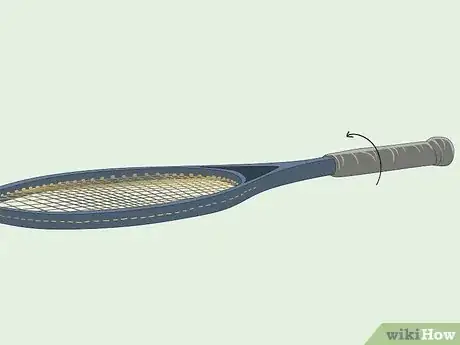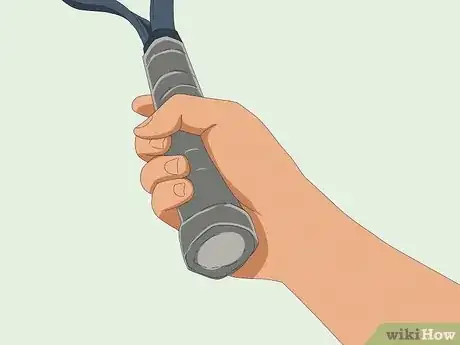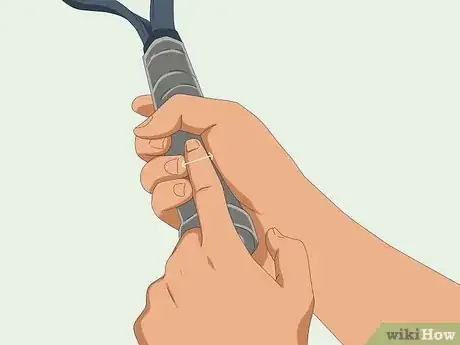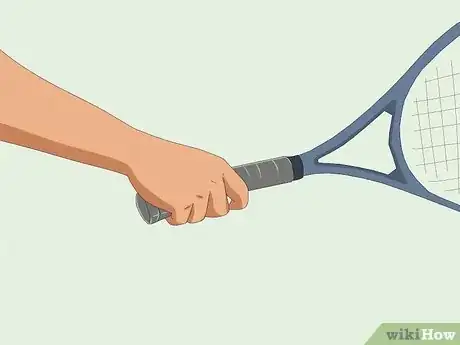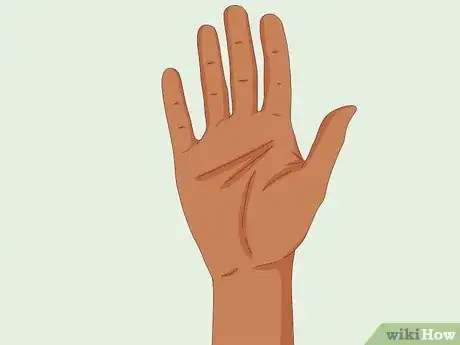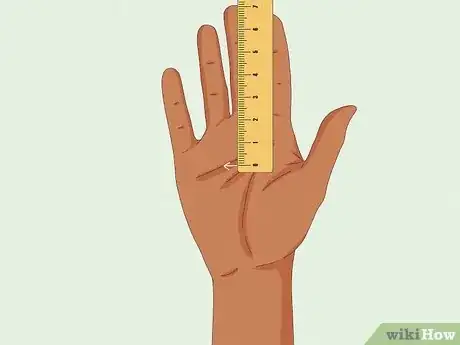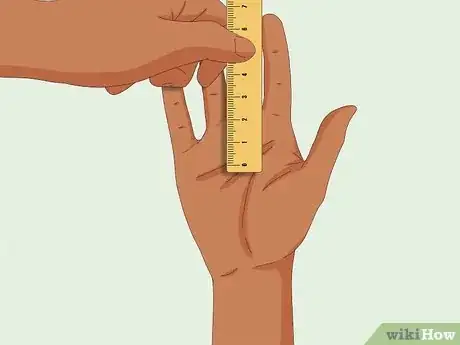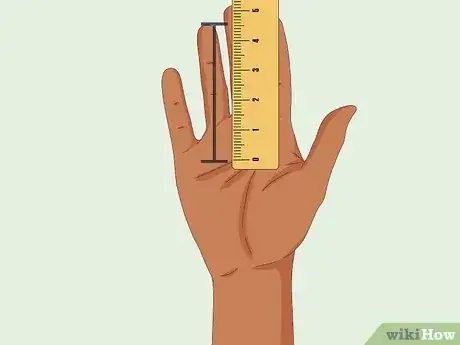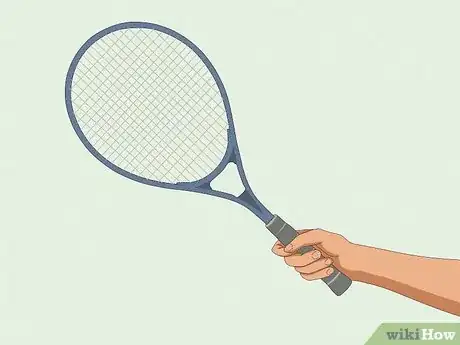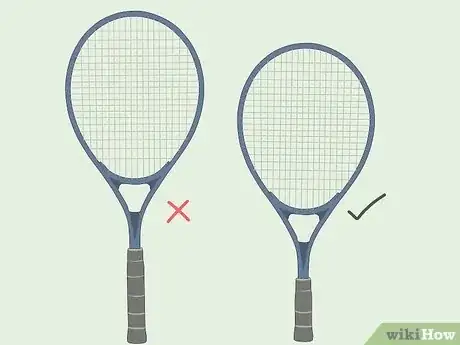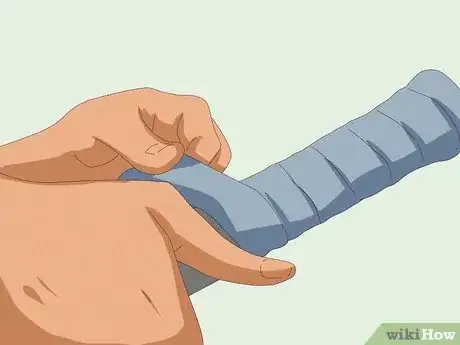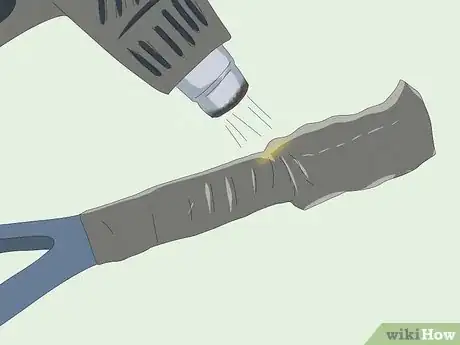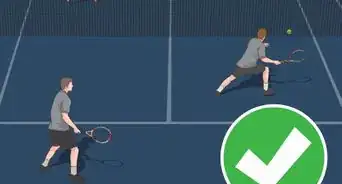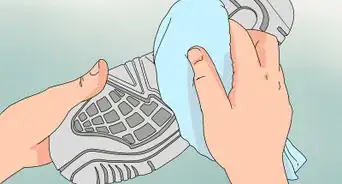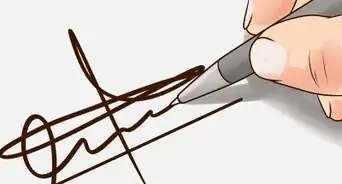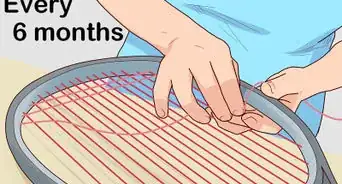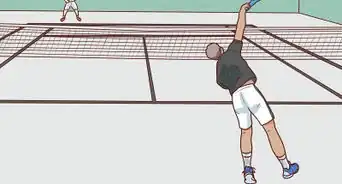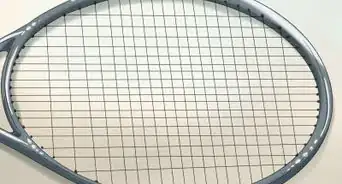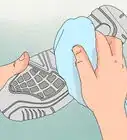This article was co-authored by Peter Fryer. Peter Fryer is a tennis writer and coach based in Derry Northern Ireland. He completed his professional teaching tennis qualification shortly after finishing university and has been teaching tennis for over 13 years. Peter began Love Tennis Blog in 2010 and contributes to the BBC and national media outlets.
This article has been viewed 45,562 times.
Choosing a tennis racket with the correct grip size can improve your play out on the court. You can figure out your grip size through 2 different tests. The index finger test utilizes rackets, but you can also use a ruler to measure your hand size. You can also adjust the grip size on your racket so it fits you better. Once you have your perfect tennis racket, head out onto the court to hit balls in comfort and style.
Steps
Testing with Your Index Finger
-
1Flip the racket on its side. For the index finger test, you estimate your grip by holding a racket. Position the racket similarly to how you would hold it while playing. Face the side of the frame towards you, keeping the strings on the sides.
-
2Place your palm on the racket handle. Wrap your hand around the bottom end of the handle like you’re about to put the racket into action. Imagine that you are holding a hammer or shaking someone's hand. You can use either side of the handle for this test.[1]
- Perform the test with the hand you normally use to hold your racket. If you are right-handed, grip the right side of the racket. If you are left-handed, grip the left side.
Advertisement -
3Wrap your fingers around the handle. Rest the knuckle of your index finger on the handle, then bring your fingers as far around as you can reach. Position your thumb below your index finger's tip. Rest your other fingers underneath your thumb and index finger, close to the bottom of the racket. Adjust your grip until you feel comfortable holding the racket.[2]
- This grip is called the Eastern forehand grip. In this grip, the first knuckle on your index finger and the heel of your palm rest on the outside edge of the handle.
- If you are familiar with tennis grips, there are a few different grips you can use to complete the test. Most people choose an Eastern or a Continental grip.
-
4Ensure your free index finger fits between your ring finger and palm. Unless the racket is too small, you will notice some space between your thumb and your other 4 fingers. Place your free index finger on the bottom of the racket’s handle. Slide your finger up the grip and between your other fingers. Your finger should fit snugly in the gap.[3]
- If your ring finger doesn’t fit, the racket is too small. Test a larger size.
- If you still have some space around your ring finger, the racket is too big. Look for smaller rackets.
-
5Test other grips until you find the correct size, if necessary. The first racket you test will give you a general idea of your grip size. Still, you may need to try out a few different rackets before you find a grip size that feels comfortable in your hand. The grip size are typically printed on the bottom of the racket handle, so use these numbers to help you find suitable rackets.[4]
- U.S. grip sizes are measured by 1⁄8 in (3.2 mm). European grip sizes are identical to U.S. grips but numbered 0 to 5.
- For example, a European size 0 is the same as 4 in (100 mm) in the U.S. Size 1 is 4 1⁄8 in (100 mm). Size 2 is 4 1⁄4 in (110 mm). Size 3 equals 4 3⁄8 in (110 mm). Size 4 is equivalent to 4 1⁄2 in (110 mm). Finally, size 5 is the same as 4 5⁄8 in (120 mm).
Measuring with a Ruler
-
1Open your hand and extend your fingers. The ruler test can be done even if you don’t have a racket available. To perform the test, hold your hand out in front of you with your palm facing upwards. Straighten your fingers, bringing your 4 main fingers together. Your thumb doesn’t need to be included, so leave it off to the side and let it rest.[5]
- This test will give you a precise numerical measurement for your grip size. However, you will still need to test rackets to figure out what feels comfortable in your hand.
-
2Line up a ruler with the lower crease in the middle of your hand. Look carefully at the creases in your hand. Near the middle, you should see 2 horizontal creases running all the way across. Place the ruler right in the middle of your hand.[6]
- Choose the hand you normally use to test the racket. The test will work the same way whether you are left or right-handed.
-
3Align the ruler with your ring finger. Move the ruler into position with your free hand. Make sure it reaches the tip of your ring finger. Keep the ruler flat with the bottom edge on your palm's crease as you take the measurement.[7]
-
4Measure from your palm to the tip of your ring finger. Once you have the ruler in position, notice where your fingertip falls on it. For adults, this will typically be between 4 to 4 5⁄8 in (100 to 120 mm). You can then use this measurement to find rackets that fit you.[8]
- If you measure in inches, round to the nearest 1⁄8 in (0.32 cm). This will help you get the correct grip size.
- If you measure in millimeters, you may want to look at a conversion chart such as at https://tenniscompanion.org/how-to-select-the-perfect-tennis-racquet-grip-size/.
-
5Find a racket size that matches your grip measurement. The grip size of a racket is usually printed on the bottom of the handle. Once you find a racket that matches your grip size, give it a few swings. If you're between sizes, choose the smaller one and consider adding an overgrip to get it to the perfect size.[9]
- Remember the label difference in U.S. and European rackets. U.S. grip sizes are measured by 1⁄8 in (3.2 mm). European grip sizes are numbered 0 to 5.
- The European size 0 is the same as a 4 in (100 mm) grip in the U.S. Size 1 is 4 1⁄8 in (100 mm). Size 2 equals 4 1⁄4 in (110 mm). Size 3 means 4 3⁄8 in (110 mm). Size 4 is the same as 4 1⁄2 in (110 mm). Finally, size 5 is 4 5⁄8 in (120 mm).
Adjusting Your Racket
-
1Choose a smaller racket if your grip measurement is between sizes. Unfortunately, rackets come in a limited range of sizes. You may not find a racket sized for your specific grip. In this case, you should still measure your grip. Unless your measurement is very close to the next racket size up, the next racket size down may be better for you since you can make the grip a little larger.[10]
- For example, if your grip size is 4 7⁄16 in (113 mm), a 4 3⁄8 in (110 mm) racket may be your best fit.
-
2Add an overgrip to slightly increase your racket’s grip size. An overgrip is a tape-like wrapping you fit over your racket handle. It adds about 1⁄16 in (1.6 mm) to the handle’s size. In addition, it also makes the handle softer, stickier, and more sweat-absorbent.[11]
- You can get overgrips wherever tennis supplies are sold. They come in a variety of patterns, so you can personalize your racket this way.
- An overgrip may need to be replaced on occasion to maintain your grip size.
-
3Use a heat shrink sleeve to add extra grip to your racket. A heat shrink sleeve is a more permanent grip solution than an overgrip. You slide the fabric over your racket handle, then heat it with a heat gun or another heat source until it shrinks. It adds about 1⁄8 in (3.2 mm) to your racket’s handle size. When you are finished using it, you cut it off of your racket.[12]
- Heat shrink sleeves can be tricky to install and remove, so you may want to use overgrips at first until you know your grip size.
Expert Q&A
-
QuestionWhat is the normal tennis grip size?
 Peter FryerPeter Fryer is a tennis writer and coach based in Derry Northern Ireland. He completed his professional teaching tennis qualification shortly after finishing university and has been teaching tennis for over 13 years. Peter began Love Tennis Blog in 2010 and contributes to the BBC and national media outlets.
Peter FryerPeter Fryer is a tennis writer and coach based in Derry Northern Ireland. He completed his professional teaching tennis qualification shortly after finishing university and has been teaching tennis for over 13 years. Peter began Love Tennis Blog in 2010 and contributes to the BBC and national media outlets.
Tennis Instructor The grip size a player needs depends of the size of their hands. Rackets come in different grip sizes, ranged from 4 1⁄8 to 4 ¾ inches. In Europe they are called from G1 to G5.
The grip size a player needs depends of the size of their hands. Rackets come in different grip sizes, ranged from 4 1⁄8 to 4 ¾ inches. In Europe they are called from G1 to G5.
Warnings
- Getting the wrong racket size can wear out your arm and cause tennis elbow. This can happen with both smaller and larger rackets.⧼thumbs_response⧽
Things You’ll Need
- Racket
- Ruler
References
- ↑ http://protennistips.net/tennis-racquet-grip-size/
- ↑ http://www.sheentennisquash.co.uk/how-to-find-your-tennis-racquet-grip-size/
- ↑ http://protennistips.net/tennis-racquet-grip-size/
- ↑ https://tenniscompanion.org/how-to-select-the-perfect-tennis-racquet-grip-size/
- ↑ http://protennistips.net/tennis-racquet-grip-size/
- ↑ https://tenniscompanion.org/how-to-select-the-perfect-tennis-racquet-grip-size/
- ↑ http://www.sheentennisquash.co.uk/how-to-find-your-tennis-racquet-grip-size/
- ↑ http://protennistips.net/tennis-racquet-grip-size/
- ↑ Peter Fryer. Tennis Coach. Expert Interview. 5 July 2019.
